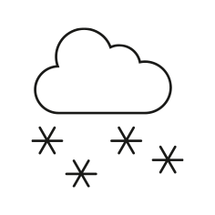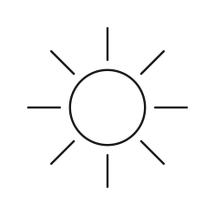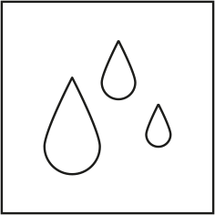Thermal insulation
Winter thermal insulation
Winter thermal insulation has the task of reducing heat loss in the building, enabling a pleasant indoor climate and ensuring permanent protection of the building structures against climate-related moisture effects and dew formation. An important contribution is made by materials with good thermal insulation properties and a building envelope that is as airtight as possible.

Summer thermal insulation
Summer thermal insulation serves to limit the heating of rooms by solar radiation. Building materials with low thermal conductivity and an airtight building envelope contribute to achieving the desired summer thermal insulation.

Moisture protection
Moisture protection is intended to protect the building structure from the effects of moisture caused by climate and use and its and its consequential damage. In order for moisture to escape from the building components (e.g. made of solid wood) or moisture entering the building can escape to the outside, the wall construction should be should be built to be more open to diffusion from the inside to the outside. An exterior wall construction is suitable for this e.g. StyleBoard MDF.RWH and stiffening planking on the inside, e.g. with LivingBoard.
For moisture protection calculations we recommend transient methods, e.g. with WUFI®. methods, e.g. with WUFI®. The moisture-dependent material parameters - humidification and re-drying - of the building materials are taken into account. of the building materials are taken into account, which makes a realistic calculation of the condensation water loss is possible.

Sound insulation
The aim of sound insulation is to reduce sound transmission in a building and to improve the quality of living through lower sound emissions. Sound insulation can be improved by using building components with a higher weight per unit area, e.g. LivingBoard. Sound transmission can also be minimised by separating building components. The use of The use of a suspended construction minimises sound transmission via the ceiling.

Sound absorption coefficient:
(The sound absorption coefficient can be taken from EN 13986).
| Panel type | Sound absorption Frequency range 250 Hz to 500 Hz | Sound absorption Frequency range 1,000 Hz to 2,000 Hz |
| PremiumBoard MFP P5 | 0,10 | 0,25 |
| LivingBoard P4 / P5 / P7 | 0,10 | 0,25 |
| LivingBoard face P5 / P7 | 0,10 | 0,25 |
| LivingBoard face contiprotect P5 / P7 | 0,10 | 0,25 |
| StyleBoard MDF.RWH | 0,10 | 0,20 |
Formaldehyde emissions in ppm
LivingBoard is manufactured with a 100% formaldehyde-free binder. As a result, the formaldehyde emission of LivingBoard is comparable to that of natural wood. LivingBoard is significantly below the emission requirements of EN 13986 (E1) and meets those of the "Blue Angel" eco-label.
The formaldehyde emissions of LivingBoard are 40% lower than the German E1.
Flexural strength transverse to the direction of manufacture in N/mm2
(Thickness: 12 mm)
High flexural strength in all board directions guarantees the processor a high board yield, optimum offcut and prevents incorrect "static use".
The flexural strength of standard OSB boards is significantly lower transverse to the direction of manufacture, whereas the flexural strength of LivingBoard is consistently high in all board directions. Across the direction of manufacture, it is even 80% higher.
Thickness swelling in %
(Thickness: 15mm)
Due to the moisture-resistant PU joint and the optimized chip geometry, LivingBoard has a significantly lower thickness swelling than standard OSB. The thickness swelling of LivingBoard P5 is 33% lower than OSB/3 according to EN 300.
Burning rate / burning speed in mm/min
(Thickness: 12 mm)
LivingBoard has an 8% lower burn rate than a standard OSB board due to its homogeneous structure and uniformly high bulk density, thus offering more safety in case of fire.
Air tightness
An airtight building envelope is important to prevent moisture damage in the construction and heat loss due to unwanted air exchange. DIN 4108 prescribes airtight building envelopes in order to prevent air flow and thus the entrainment of room air humidity, which can lead to condensation in the construction.
In order to reliably meet the air tightness requirements (Blower Door Test), it is necessary to seal timber joints and connections. LivingBoard offers an advantage here, because sealing with adhesive tapes is possible with common adhesive tape manufacturers without the application of primer. The width of the adhesive tapes should be at least 6 cm. They should be positioned centrally over the butt joint. If the adhesive tapes overlap, e.g. at T-joints, suitable measures must be taken. The manufacturer's processing guidelines must be observed.

Recommendation adhesive tapes
| Indoor | Connections and penetrations |
| SIGA Sicrall®, SIGA Cover AG, Ruswil (Switzerland) Ampacoll® INT, Ampack AG, Rorschach (Switzerland) RAPID CELL, Pro clima/MOLL GmbH, Schwetzingen (Germany) UNI TAPE, Pro clima/MOLL GmbH, Schwetzingen (Germany) | Ampacoll® BK 535, Ampack AG, Rorschach (Switzerland) |
Fire protection
Fire protection is a high priority for a building in timber construction. The requirements for fire protection are specified in national building regulations. The Pfleiderer wood-based materials PremiumBoard, LivingBoard and StyleBoard MDF.RWH are classified in Euroclass D-s2, d0 1) from a thickness of ≥ 9 mm and a gross density of ≥ 600 kg/m³ of EN 13986.

Burning rate
For Pfleiderer wood-based materials, the following burn-up rates result according to Eurocode EN 1995-1-2:
| Calculated burn rate in mm /min | ||||||||
| Thickness in mm | ||||||||
| 12 | 13 | 15 | 16 | 18 | 19 | 22 | 25 | |
| LivingBoard face P5 / P7 | 0,97 | 0,90 | 0,82 | 0,78 | 0,73 | |||
| LivingBoard face contiprotect P5 / P7 | 0,97 | 0,90 | 0,82 | 0,78 | 0,73 | |||
| PremiumBoard MFP P5 | 0,97 | 0,90 | 0,82 | 0,78 | 0,73 | |||
| LivingBoard P4 / P5 / P7 | 0,93 | 0,87 | 0,8 | 0,78 | 0,73 | |||
Formaldehyde emissions in ppm
LivingBoard is manufactured with a 100% formaldehyde-free binder. As a result, the formaldehyde emission of LivingBoard is comparable to that of natural wood. LivingBoard is significantly below the emission requirements of EN 13986 (E1) and meets those of the "Blue Angel" eco-label.
The formaldehyde emissions of LivingBoard are 40% lower than the German E1.
Flexural strength transverse to the direction of manufacture in N/mm2
(Thickness: 12 mm)
High flexural strength in all board directions guarantees the processor a high board yield, optimum offcut and prevents incorrect "static use".
The flexural strength of standard OSB boards is significantly lower transverse to the direction of manufacture, whereas the flexural strength of LivingBoard is consistently high in all board directions. Across the direction of manufacture, it is even 80% higher.
Thickness swelling in %
(Thickness: 15mm)
Due to the moisture-resistant PU joint and the optimized chip geometry, LivingBoard has a significantly lower thickness swelling than standard OSB. The thickness swelling of LivingBoard P5 is 33% lower than OSB/3 according to EN 300.
Burning rate / burning speed in mm/min
(Thickness: 12 mm)
LivingBoard has an 8% lower burn rate than a standard OSB board due to its homogeneous structure and uniformly high bulk density, thus offering more safety in case of fire.
Statics
The design of timber structures should be based on national and European standards and building regulations. In Europe, it is carried out according to Eurocode 5. In addition, a so-called national application document (NAD) may have to be observed in the EU member states. Pfleiderer products are regulated in the Construction Products Regulation and are approved by the building authorities in accordance with the European standard EN 13986. The characteristic values for the design of timber structures for Pfleiderer engineered wood can be found in EN 12369-1, the most important values can be found on p. 64 of the following brochure.
Have a look in our brochure

Would like to learn more?
Feel free to contact us directly! We look forward to hearing from you.
